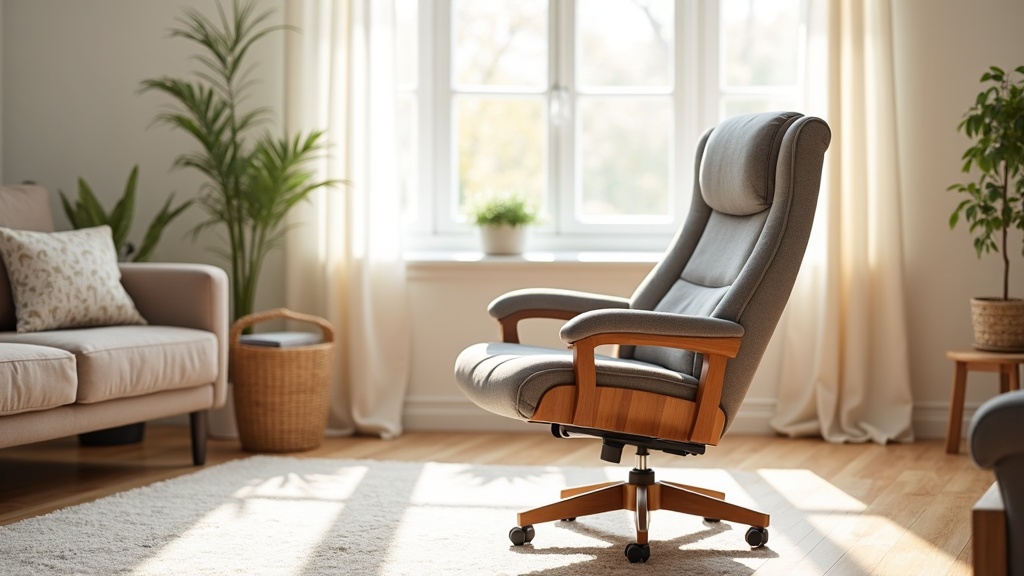An ergonomic chair can truly make a big difference in daily comfort and safety, especially for seniors. Finding the right seating solution usually means looking beyond trendy designs and focusing on features that make life easier. That is where this ergonomic seating solutions for seniors post comes to aid you!
Based on my experience, a chair that’s the right height, provides steady support, and is easy to stand up from can seriously reduce fall risk and give a big boost to independence. Let’s break down what to look for, along with some practical tips to keep everything running smoothly over time.

The Importance of Ergonomic Seating for Seniors
The right chair supports healthy posture, makes day-to-day activity more comfortable, and cuts down on the struggle of sitting and standing up. I’ve seen with my grandparents how the wrong chair can lead to aches, poor balance, and even falls over time.
In fact, according to NHS fall prevention guidance, many falls for older adults actually happen as they move in and out of seats. That’s why seat design and stability are super important in these situations.
Ergonomic seating isn’t just about comfort—it’s essential for keeping the body well-supported. This method maintains a natural spinal curve, relieves joint pressure, and lessens the strain and exhaustion of everyday tasks like eating, watching TV, and conversing with family.
Key Features to Look for in an Ergonomic Chair
With so many models out there, it’s easy to get lost in all the options. Instead of just adding extra bells and whistles, I always advise concentrating on useful features that genuinely make a chair safer and more comfortable for seniors. Here are the things I’ve found really help:
- Seat Height: The sweet spot is usually 45–48 cm. This range helps most people keep their feet flat on the floor, which goes a long way toward maintaining balance. A seat that’s either too high or too low can make standing up risky and uncomfortable.
- Seat Firmness: Highdensity foam or firm springs are the way to go. If the seat is too soft, getting up becomes a workout; if it’s rock-hard, it’s just not cozy. Breathable upholstery makes a difference for long periods of sitting, keeping things pleasant without sticking.
- Lumbar Support: Chairs with a soft curve or built-in support on the lower back help hold the spine in its natural shape, easing back pain and making it more comfortable for hours of use.
- Armrests: Look for wide, sturdy, and adjustable ones. They offer the leverage that helps with standing up and take pressure off elbows and wrists. Padded or gently angled arms add a layer of comfort you’ll appreciate.
- Base Stability: A wide base with rubber feet—or a strong fiveleg frame for swivel chairs—helps prevent wobbling. On carpet, rubber grips or lockable casters keep the chair steady and safe.
- Swivel & Tilt: A moderate swivel motion (90–180°) is enough for most. Too much and things feel unstable, but a bit of movement makes getting in and out less awkward. A gentle tilt or small amount of recline can help with pressure relief without sacrificing safety or easy exit.
Buying Tips: Choosing the Right Ergonomic Chair for Seniors
When picking out a seniorfriendly chair, thinking practically matters much more than chasing after overhyped extras. I recommend doing the following before locking in your choice:
- Measure Your Space: Ensure the chair fits with enough room for easy movement and the seat has the right width and depth for the user.
- Check Weight Capacity: Good chairs boast a capacity of at least 120 kg for durability. Always double-check manufacturer specs.
- Test Before You Buy: Let the user try sitting and standing in the chair, if possible. Real-life comfort and steadiness mean more than online photos.
- Read Reviews: Look for feedback on daily use, cleaning, and assembly. Sites with lots of user photos and detailed writeups (like Amazon or Trustpilot) help spot any recurring issues or standout features.
- Pick the Right Upholstery: Grippy fabrics like textured weaves cut down on sliding, while removable covers make cleaning much less of a chore.
From my experience, chairs in the £300–£500 price range do the best at balancing quality, comfort, and thoughtful features. No need to break the bank for gadgets you might never use—go for something sturdy and userfriendly instead.
Features That Are Nice (But Not Necessary)
Some chairs pile on technology and “luxury” features, which are nice for some folks but often unnecessary. If you have wiggle room in your budget, though, these extras might come in handy:
- USB Charging Ports: Useful for charging phones or tablets straight from your chair.
- Built-in Heat Pads: Great for easing muscle aches or arthritis pain, but you can also grab plug-in versions if needed.
- Lift-Assist: A powered lifting feature is a gamechanger for those with limited mobility, making standing up smooth and safe. These models are especially helpful for post-surgery recovery or users who get tired easily.
Just remember, powered features mean cables, so make sure they won’t create a trip hazard in busy spaces.
Maintenance for Ergonomic Seating
A wellmaintained ergonomic chair can bring years of safe and comfortable use. A tiny bit of regular upkeep makes a surprising difference. Here’s what keeps the chairs in my home looking sharp and performing well:
- Tighten Bolts and Screws: It’s smart to check fasteners every month or two. Moving chairs around can slowly loosen things over time.
- Vacuum and Dust Regularly: Keeping the seat, corners, and crevices clean helps fight allergens and stops fabric from wearing out prematurely.
- Clean Upholstery: Removable covers can be tossed in the wash. For nonremovable fabrics, stick to recommended spot-cleaners. Leathers need the occasional wipe-down with conditioner, while vinyl just needs a damp cloth.

Common Challenges and What to Watch For
Through personal experience and talks with friends and family, I’ve picked up some key lessons in choosing ergonomic chairs for seniors. Here are a few common obstacles to skip:
- Getting the Height Wrong: If the seat’s too low, standing up turns into a struggle. Too high, and feet dangle, making balance tricky and less safe.
- Armrests That Get in the Way: Fixed arms sometimes bump into tables or desks and limit flexibility. Opt for adjustable or removable arms whenever available.
- Slippery Surfaces: Smooth upholstery can make sliding off a risk. A textured cushion or a grippy cover usually fixes this quickly.
- Assembly Hassles: Some chairs arrive in multiple pieces and the instructions can be confusing. If you don’t like DIY projects, ask about professional in-home setup or recruit a helpful friend.
Real-World Use: Applications Beyond the Living Room
Ergonomic chairs aren’t just about TV time. I’ve noticed they really shine in a variety of household settings:
- Dining Areas: Upright support and comfortable armrests make mealtime safer and more enjoyable, especially if getting up and down is tricky.
- Home Offices: Seniors handling bills, hobbies, or light computer work at a desk benefit from good seating, helping prevent discomfort or longterm pain.
- Bathrooms or Dressing Spots: A sturdy, stable chair or bench makes bathing and changing much easier and more independent.
Having adaptable seats supports safe movement and comfort all around the home, not just in the lounge.
Frequently Asked Questions
Here are a few questions people often ask when searching for ergonomic seating for older adults:
What makes a chair “ergonomic” for seniors and not just comfy?
For seniors, an ergonomic chair goes beyond basic comfort to provide support at key areas like lower back and arms, maintains the right height, remains steady, and makes sitting and standing up safe and easy.
Do I need a lift chair, or will a regular ergonomic seat do?
Lift-assist models are super helpful for people with limited movement or those recovering from surgery. If an older adult still has good leg strength, a solid ergonomic chair without the power-lift function is usually just fine.
Which upholstery is best for seniors?
Textured, washable fabrics offer better grip and easy care. Removable covers are a bonus, while leather and vinyl are quick to clean but can feel a little slick.
The most important thing is choosing a chair that feels safe and supportive. The right chair lets seniors stay confident and active, making daily life both comfortable and independent.
Thanks for stopping by and have a great day!



